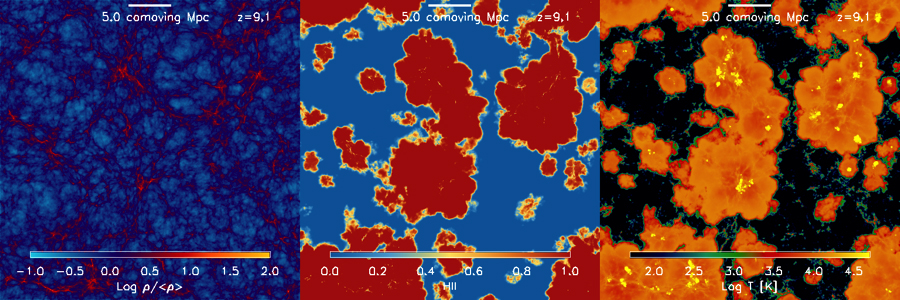ASTROPHYSICS
Aurora – Simulating Cosmic Reionization
Principal Investigator:
Dr. Andreas Pawlik
Affiliation:
Max-Planck-Institut für Astrophysik, Garching (Germany)
Local Project ID:
pr83le
HPC Platform used:
SuperMUC of LRZ
Date published:
A multi-million compute hours allocation by the Gauss Centre for Supercomputing on HPC system SuperMUC of the Leibniz Supercomputing Centre (LRZ) was used to carry out Aurora, a new set of radiation-hydrodynamical simulations of galaxy formation during reionization. Numerical simulations have emerged as the most powerful tools for the ab initio theoretical treatment of reionization.
The ionizing radiation emitted by the first stars and galaxies photoionized and photoheated the cold and neutral cosmic gas that filled space shortly after the birth of the universe in the Big Bang. This started the epoch of reionization, which took place in the first billion years, and which left galaxies embedded in a warm and ionized intergalactic medium. A new generation of telescopes such as the Low Frequency Array and the James Webb Space Telescope is currently underway to help scientists unravel the astrophysics of reionization, creating exciting opportunities to test and improve the understanding of the universe. This report summarizes how a multi-million compute hours allocation by the Gauss Centre for Supercomputing on SuperMUC at the Leibniz Supercomputing Centre (LRZ) was used to carry out Aurora, a new set of radiation-hydrodynamical simulations of galaxy formation during reionization.
Numerical simulations have emerged as the most powerful tools for the ab initio theoretical treatment of reionization. The prime challenge is the need to transport ionizing photons in large cosmological volumes with structure on a large range of scales and with many stars and galaxies emitting radiation. Aurora addresses this challenge by using a novel spatially adaptive radiation transport technique that solves multi-scale problems efficiently and has a computational cost independent of the number of radiation sources. In addition to ionizing radiation, Aurora tracks the explosion of stars as supernovae and the enrichment of the universe with metals synthesized in the stars. The Aurora simulations make detailed predictions of reionization by galaxies that will be tested in observations with the upcoming telescopes and also let scientists compare against existing observational constraints.

Figure 1: Snapshot of the Aurora reionization simulations carried out on SuperMUC at LRZ. From left to right, panels show the density (blue is underdense, red/yellow is overdense), ionized fraction (blue is neutral, red is ionized), and the temperature (black is cold, orange/yellow is hot) of the gas in a thin central slice through the simulated cubical volume of linear size 35 Mpc just a few hundred million years after the Big Bang. Galaxies form in the densest regions and emit radiation that photoionizes and photoheats the gas surrounding them. Reionization is complete once the individual ionized regions overlap, which happens about one billion years after the Big Bang. The localized regions of very high temperatures are caused by the explosions of stars as supernovae.
Copyright: Max Planck Institute for Astrophysics, Garching/GermanyExciting initial results from Aurora include that the coupling of galaxy formation and reionization by photoheating is very strong, and that an accurate treatment of feedback from photoheating and supernovae is key to reproducing observed properties of the early universe. The researchers are currently extending the suite of Aurora simulations using a follow-up multi-million hours compute time allocation on SuperMUC by PRACE, the Partnership for Advanced Computing in Europe. This will provide a rich source of information both for scientists who study the first galaxies and their evolution and for scientists who study the reionization of the universe.
A typical Aurora simulation requires about 4,000 compute cores over a period of several months and generates many terabytes of data. The compute time awards on SuperMUC by the Gauss Centre for Supercomputing and by PRACE were therefore critical for carrying out the Aurora simulation program.
Scientific team:
Dr. Andreas Pawlik (PI -- MPI for Astrophysics, Garching near Munich/Germany), Prof. Joop Schaye (Leiden University/The Netherlands), Dr. Ali Rahmati (ITP Zuerich/Switzerland), and Dr. Claudio Dalla Vecchia (IAC Tenerife/Spain).
Dr. Andreas Pawlik
Max-Planck-Institut für Astrophysik
Karl-Schwarzschild-Strasse 1
D-85748 Garching/Germany
e-mail: pawlik@mpa-garching.mpg.de